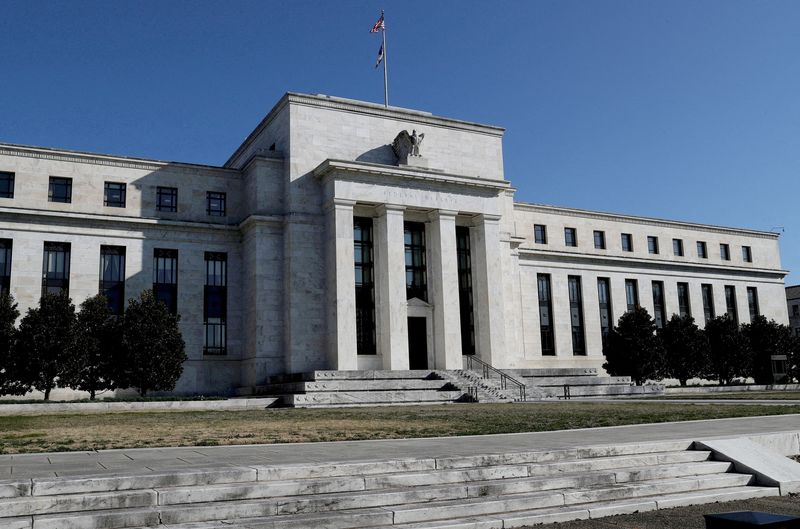Speed of US bank failures to play starring role in Fed, FDIC post-mortems
2023.04.27 02:54
2/2

© Reuters. FILE PHOTO: The Federal Reserve building is pictured in Washington, U.S., on March 19, 2019. REUTERS/Leah Millis/File Photo
2/2
By Hannah Lang and Ann Saphir
WASHINGTON/SAN FRANCISCO (Reuters) – Of all the facts that have emerged about last month’s two U.S. bank busts – the unanswered warning letters from regulators, the ignored interest-rate risk, the outsized levels of uninsured deposits – one data point in particular continues to stir deep-seated unease among finance officials: 36.
That’s roughly the number of hours it took Silicon Valley Bank (SVB) to go from a functioning regional lender to being seized by regulators after the fastest bank run in U.S. history saw $42 billion of deposits yanked in 24 hours, with another $100 billion queued for the door before the California-based bank was shut down.
Signature Bank (OTC:)’s failure took only marginally longer.
As regulators at the Federal Reserve and Federal Deposit Insurance Corporation prepare to release a pair of post-mortems on Friday that will lay out what went wrong, the staggering speed of the second- and third-largest U.S. bank failures ever remains a primary focus. Moreover, beyond whether the bank examiners could have been sharper-eyed or tougher-knuckled, the ongoing question of whether they could just have moved faster remains a central concern.
“The number 36 has just been, you know, branded in my brain,” Atlanta Fed President Raphael Bostic told Reuters earlier this month. “How should we be thinking about relationships given that speed? And how do we think about protocols given that speed?”
Indeed, even as officials put the finishing touches on the two reports, a real-life next test was emerging: First Republic Bank (NYSE:) this week reported more than a $100 billion plunge in deposits in the first quarter, sending its shares sliding to a record low and prompting speculation over the future of the 14th-largest U.S. bank.
Bostic, for one, was already gearing up for more. He said he has had conversations with banks in his region about the need for communication and familiarity with the tools they might need in such a circumstance, such as how to access the U.S. central bank’s emergency lending facilities.
“I think ultimately, we’ve all got to basically operate like we’re on yellow alert at all times,” he said.
‘SKUNKS AT THE PARTY’
The Fed’s report will focus on SVB, which regulators took over on March 10 after a failed emergency effort to raise capital helped trigger the deposit run.
Fed Vice Chair for Supervision Michael Barr has said the review will include policy recommendations, as well as confidential supervisory information that is not usually made public.
“I think that any time you have a bank failure like this, bank management clearly failed, supervisors failed and our regulatory system failed,” Barr told U.S. lawmakers in a hearing in March.
The FDIC’s report on the supervision of New York-based Signature Bank, which was closed a couple of days after SVB, is also due on Friday.
A separate report on the deposit insurance system that FDIC Chair Martin Gruenberg has said will include a rundown of potential reforms is expected by Monday.
The supervisory regime at both regulators is under scrutiny from lawmakers on both sides of the aisle who have questioned why bank examiners weren’t more aggressive in pursuing fixes at the failed banks.
“The supervisors tend to be the skunks at the party – they are the ones who point out what the deficiencies are,” Sarah Bloom Raskin, a former Fed governor, said at an event held by the Peterson Institute for International Economics on Wednesday.
“It appears that there was really a lack of urgency in escalating this through the supervisory channel … That lack of follow-through needs to be examined,” she said.
‘SIGNIFICANT SUPERVISORY FAILURE’
Some policymakers have argued that rules relaxing the strictest oversight for firms holding between $100 billion and $250 billion in assets, which included SVB and Signature, are also in part to blame.
“The lessons (from the reports) aren’t going to be, how to identify the next SVB,” said Kathryn Judge, a professor at Columbia Law School. “It’s how do we allow a bank whose failure threatened the financial system to persist without being subject to more aggressive intervention?”
Daniel Tarullo, who headed supervision and regulation at the Fed until 2017, said the correct policy fixes will depend on how much of the blame for the failures is due to the banks’ particularities – far higher proportions of uninsured deposits than is the norm, along with large holdings of long-term securities that lost value as short-term interest rates rose.
“One thing for certain … this was a very significant supervisory failure,” Tarullo said at the Peterson Institute for International Economics event on Wednesday.
If the banks’ failures and speed with which they occurred are seen as more of a “canary in the coal mine” for problems that could crop up more frequently in the future, bigger changes in the regulatory regime may be needed, he said.








